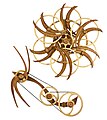
Kinetic art is art from any medium that contains movement perceivable by the viewer or that depends on motion for its effect. Canvas paintings that extend the viewer's perspective of the artwork and incorporate multidimensional movement are the earliest examples of kinetic art. More pertinently speaking, kinetic art is a term that today most often refers to three-dimensional sculptures and figures such as mobiles that move naturally or are machine operated. The moving parts are generally powered by wind, a motor or the observer. Kinetic art encompasses a wide variety of overlapping techniques and styles.

Woodturning is the craft of using a wood lathe with hand-held tools to cut a shape that is symmetrical around the axis of rotation. Like the potter's wheel, the wood lathe is a simple mechanism that can generate a variety of forms. The operator is known as a turner, and the skills needed to use the tools were traditionally known as turnery. In pre-industrial England, these skills were sufficiently difficult to be known as 'the misterie' of the turners guild. The skills to use the tools by hand, without a fixed point of contact with the wood, distinguish woodturning and the wood lathe from the machinist's lathe, or metal-working lathe.

A whirligig is an object that spins or whirls, or has at least one part that spins or whirls. It can also be a pinwheel, spinning top, buzzer, comic weathervane, gee-haw, spinner, whirlygig, whirlijig, whirlyjig, whirlybird, or simply a whirly. They are most commonly powered by the wind but can be hand-, friction- or motor-powered. They can be used as kinetic garden ornaments, and can be designed to transmit sound and vibration into the ground to repel burrowing rodents.

Theodorus Gerardus Jozef Jansen is a Dutch artist. In 1990, he began building large mechanisms out of PVC that are able to move on their own and, collectively, are entitled, Strandbeest. The kinetic sculptures appear to walk. His animated works are intended to be a fusion of art and engineering. He has said that "The walls between art and engineering exist only in our minds." He strives to equip his creations with their own artificial intelligence so they may avoid obstacles such as the sea, by changing course when detected.

Ralfonso "Ralf" Gschwend is a Swiss kinetic sculptor.
The American Association of Woodturners (AAW) is the principal organization in the United States supporting the art and craft of woodturning. It is sometimes stylized as American Association of Wood Turners (AAW). Established in 1986 and headquartered in Saint Paul, Minnesota, the organization encompasses more than 15,000 members in the United States and many foreign nations. As of 2013, the AAW was affiliated with nearly 350 local chapters worldwide. In addition to sponsoring an annual national symposium, the AAW provides support to local clubs for outreach and education. The 25th anniversary of the AAW was celebrated in 2011 at the annual symposium held in Saint Paul. Phil McDonald is executive director of the organization.
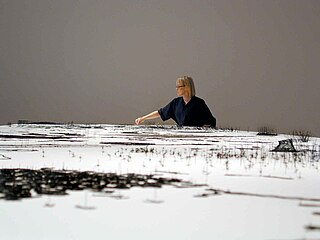
Anne Wilson is a Chicago-based visual artist. Wilson creates sculpture, drawings, Internet projects, photography, performance, and DVD stop motion animations employing table linens, bed sheets, human hair, lace, thread and wire. Her work extends the traditional processes of fiber art to other media. Wilson is a professor in the Department of Fiber and Material Studies at The School of the Art Institute of Chicago.
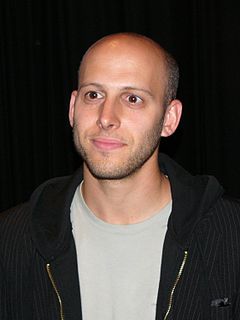
Jeff Lieberman is an artist and engineer working in a wide variety of artistic and technological media. He was also the host of the documentary show Time Warp on Discovery Channel, and directed a number of short films featuring greatly speeded-up or slowed-down time sequences.
Mark Lindquist is an American sculptor in wood, artist, author, and photographer. Lindquist is a major figure in the redirection and resurgence of woodturning in the United States beginning in the early 1970s. His communication of his ideas through teaching, writing, and exhibiting, has resulted in many of his pioneering aesthetics and techniques becoming common practice. In the exhibition catalog for a 1995 retrospective of Lindquist's works at the Renwick Gallery of the Smithsonian American Art Museum, his contributions to woodturning and wood sculpture are described as "so profound and far-reaching that they have reconstituted the field". He has often been credited with being the first turner to synthesize the disparate and diverse influences of the craft field with that of the fine arts world.

Jansen's linkage is a planar leg mechanism designed by the kinetic sculptor Theo Jansen to generate a smooth walking motion. Jansen has used his mechanism in a variety of kinetic sculptures which are known as Strandbeesten. Jansen's linkage bears artistic as well as mechanical merit for its simulation of organic walking motion using a simple rotary input. These leg mechanisms have applications in mobile robotics and in gait analysis.
Angela Conner FRBS is an English sculptor who works in London. Conner has exhibited internationally and has large scale sculptures in public and private collections around the world.

Robert Perless is an American artist whose particular focus is kinetic art sculptures.
Noeline Brokenshire was New Zealand sportswoman, who represented her country in field hockey, and as a hurdler at the 1950 British Empire Games. Later she was a gallery owner and noted woodturner, and the founder and publisher of New Zealand's first woodworking magazine, Touch Wood.
Kay Sekimachi is an American fiber artist and weaver, best known for her three-dimensional woven monofilament hangings as well as her intricate baskets and bowls.
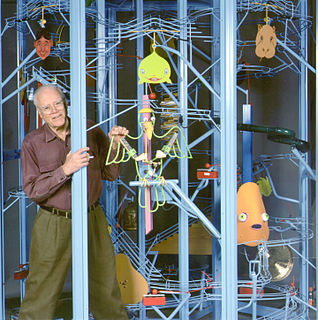
George Rhoads was a contemporary American painter, sculptor, and origami master. He was best known for his whimsical audiokinetic sculptures in airports, science museums, shopping malls, children’s hospitals, and other public places throughout the world.
Binh Pho was a Vietnamese-American artist best known for his pierced and painted works in wood.
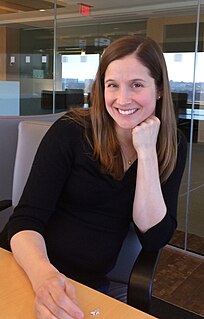
Karen Ann Rubin is an entrepreneur. She joined HubSpot where she co-hosted HubSpot TV, and was entrepreneur-in-residence at Matrix Partners in 2013-2014. In 2014, she joined Quantopian as Vice President of Product Management. In 2015 she authored a study that shows that women-led companies perform better than average. She started her career in 2004 in investment banking.

Halo is a wind powered kinetic sculpture in Sydney, Australia. Located at Central Park, the artwork is part of a major mixed-use urban renewal project to redevelop the old Kent Brewery site in Broadway.

Michelle Holzapfel is an American woodturner and a participant in the American Craft movement. Michelle Holzapfel has five decades of experience turning and carving native hardwoods in Marlboro, Vermont, where she has lived her adult life. Holzapfel fits the definitions of both Studio artist and Material movement artist. A product of the revolutionary back-to-the-earth movement of 1960s and 1970s, she attributes the expressiveness of her turned and carved forms to the idealism of those years. Raised in rural Rhode Island, she has worked alone in her Vermont studio—shared only with her husband, the furniture maker and educator David Holzapfel—since 1976. Her wood pieces which feature intricate carvings have been exhibited in museums and galleries in the U.S., Australia and Europe. Publications featuring her work include but are not limited to House Beautiful, American Craft, Woodworking, and Fine Woodworking.
Alexandre da Cunha is a Brazilian-British artist, who produces sculpture and wall mounted works, often using found objects. His works have been exhibited around the world, and are located in several major public collections.





